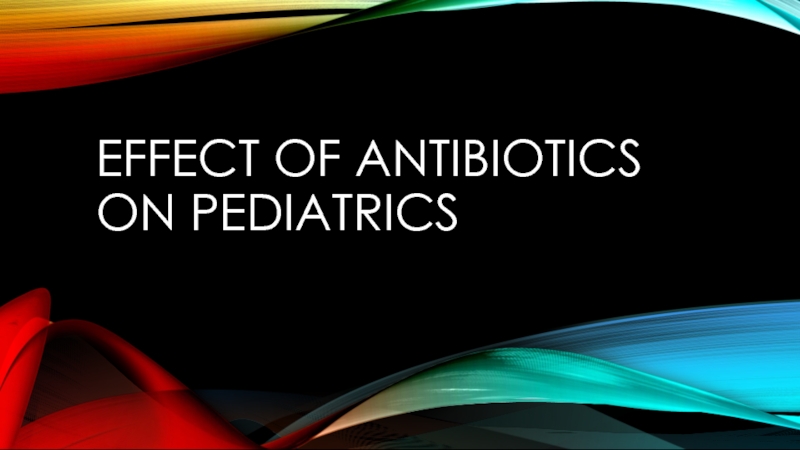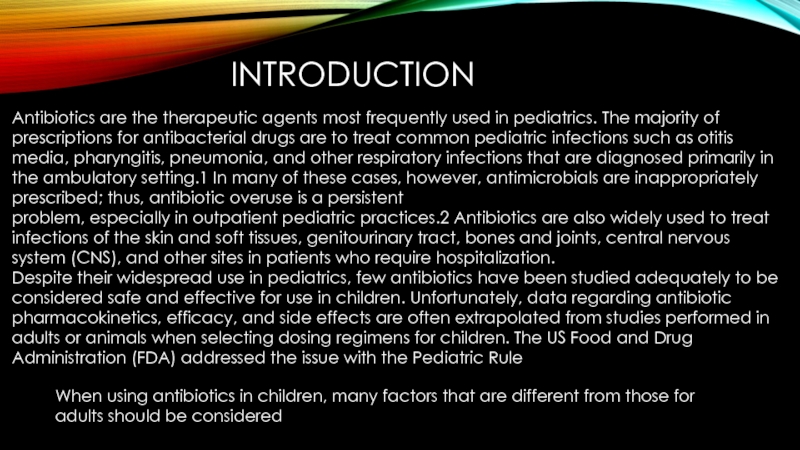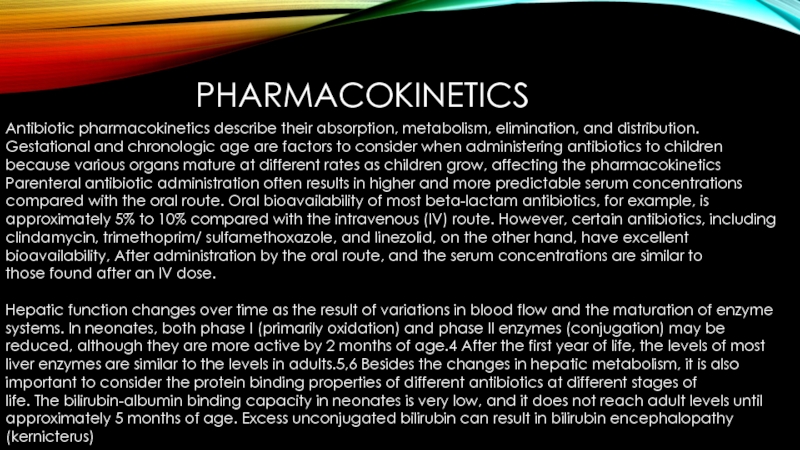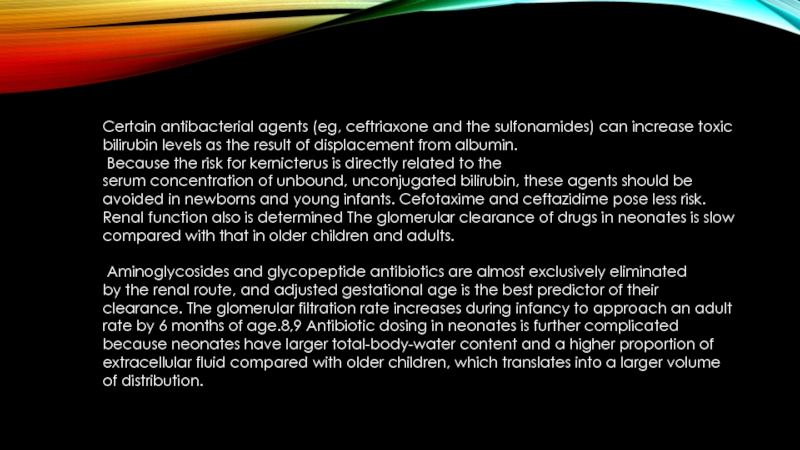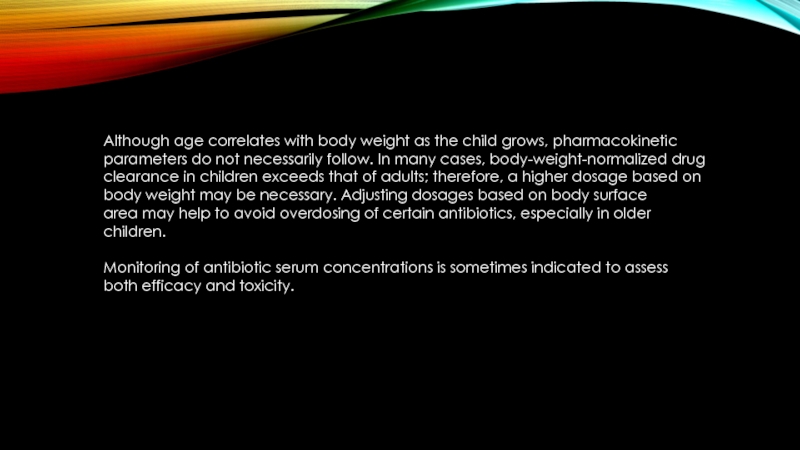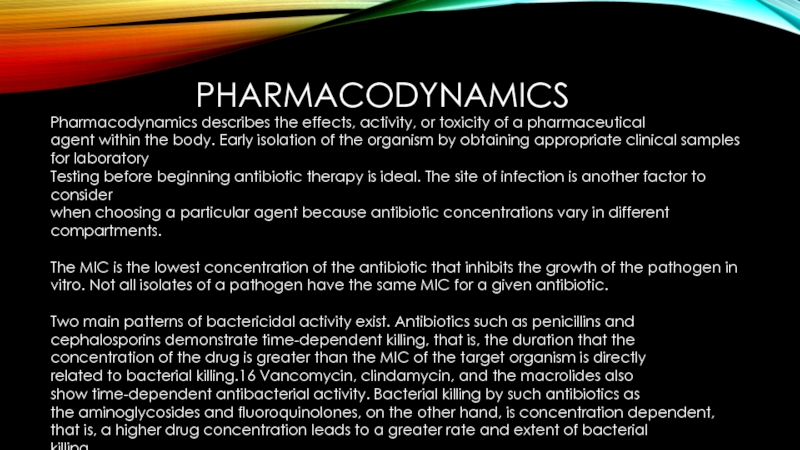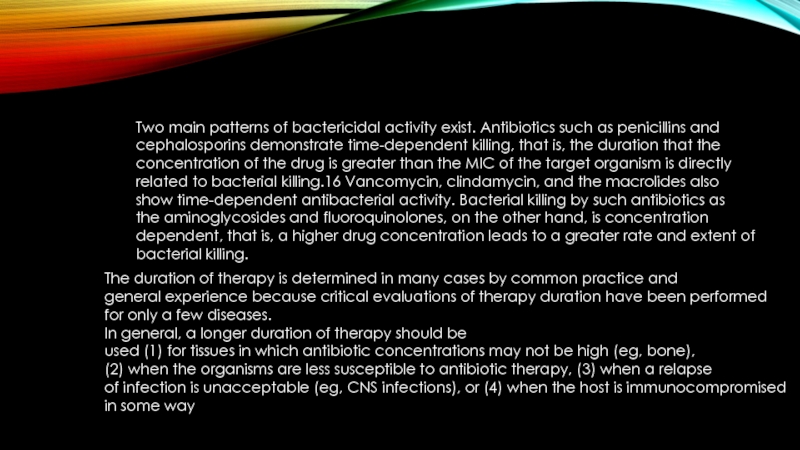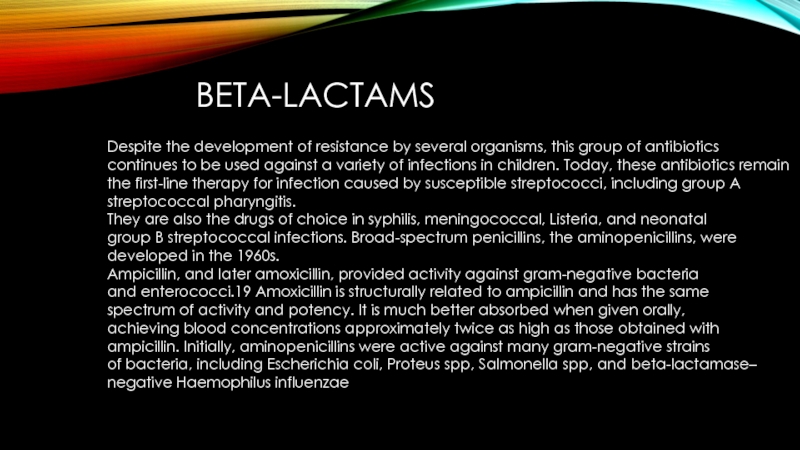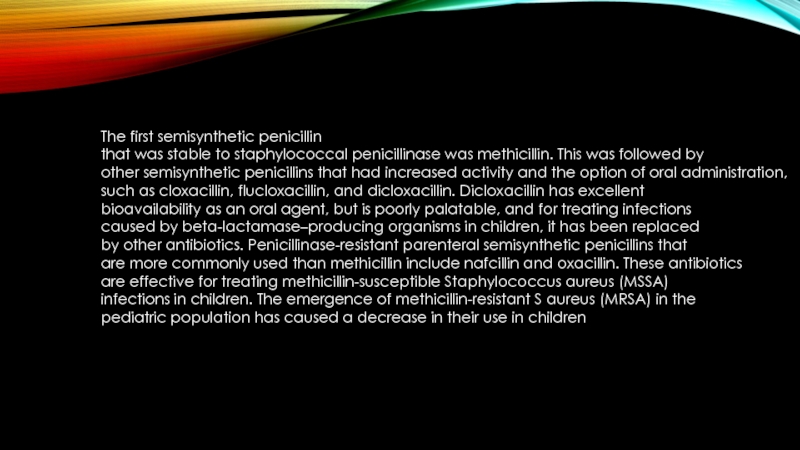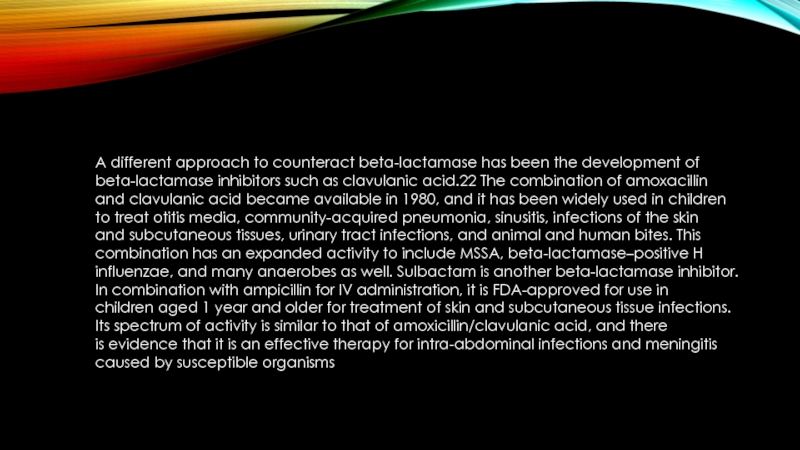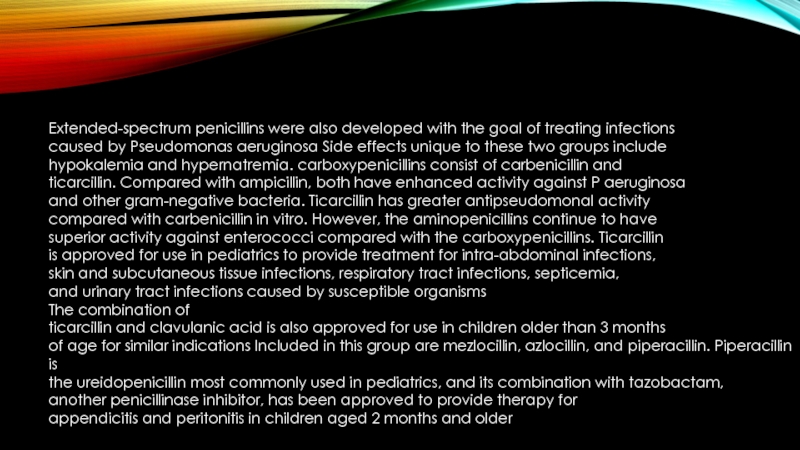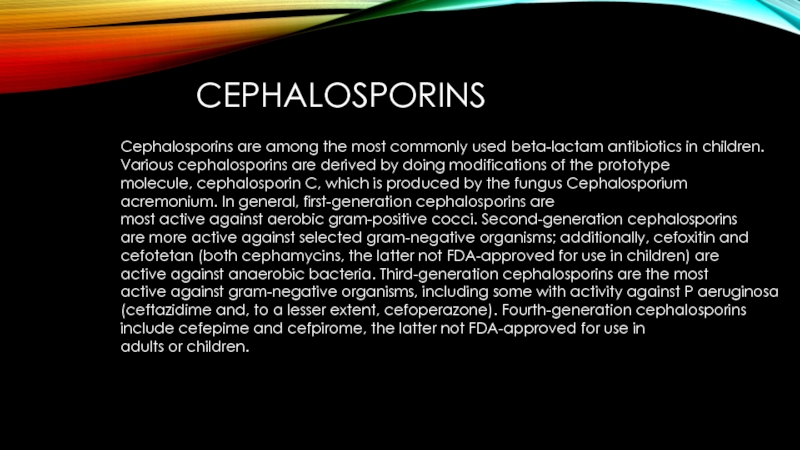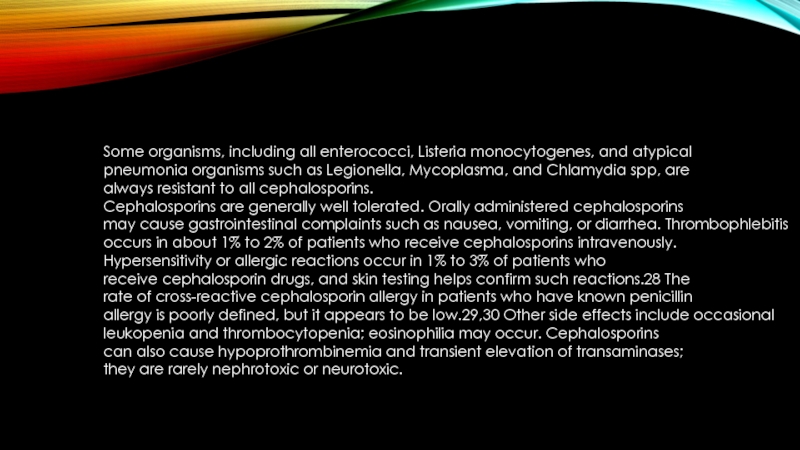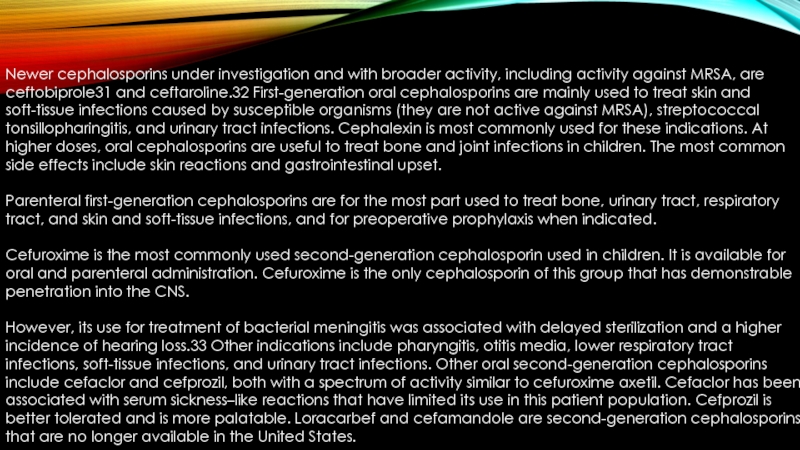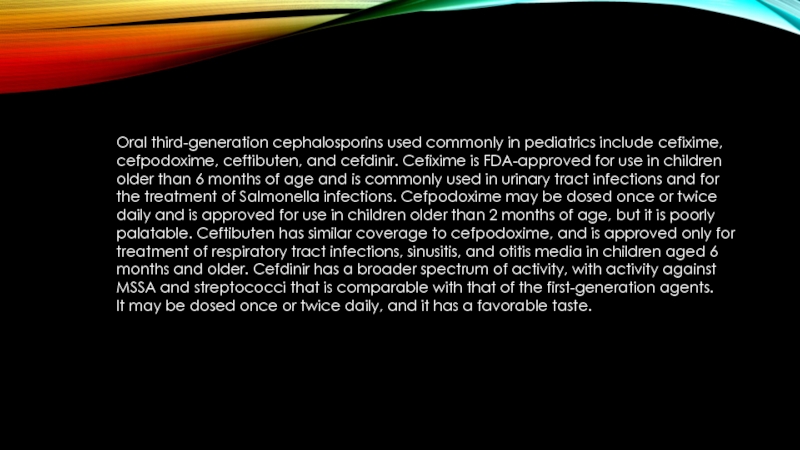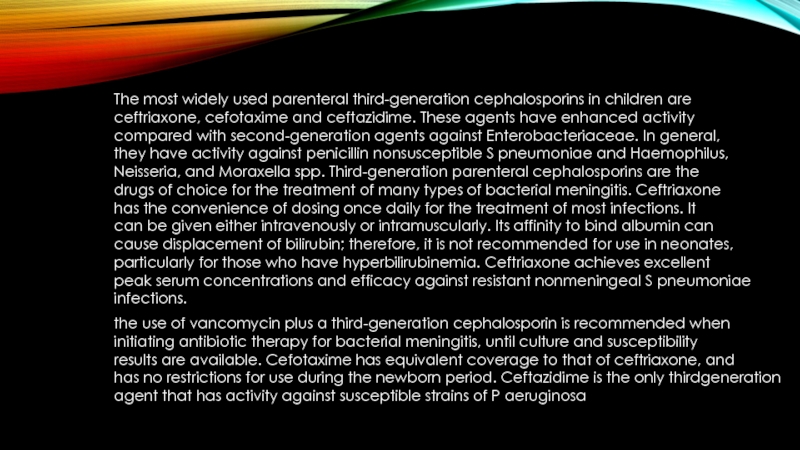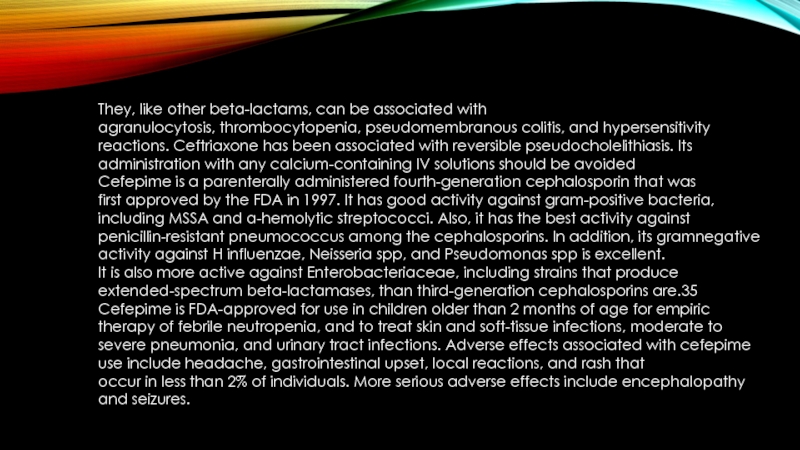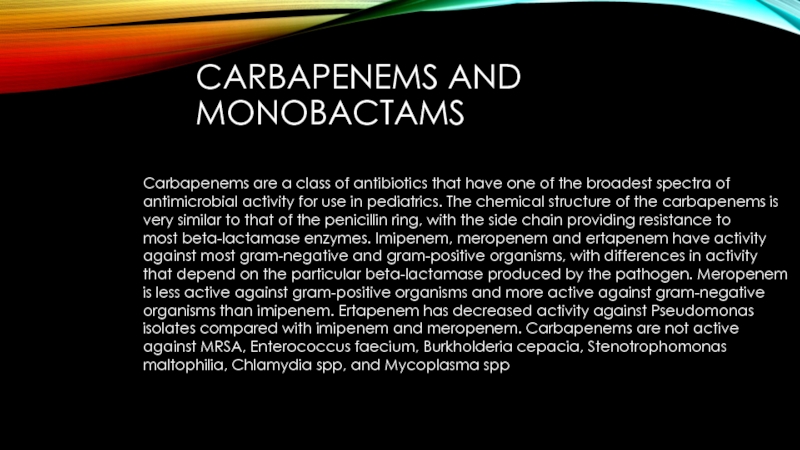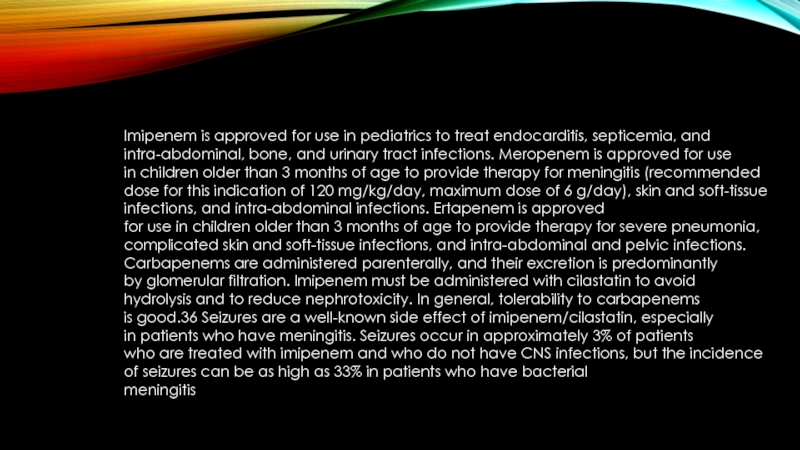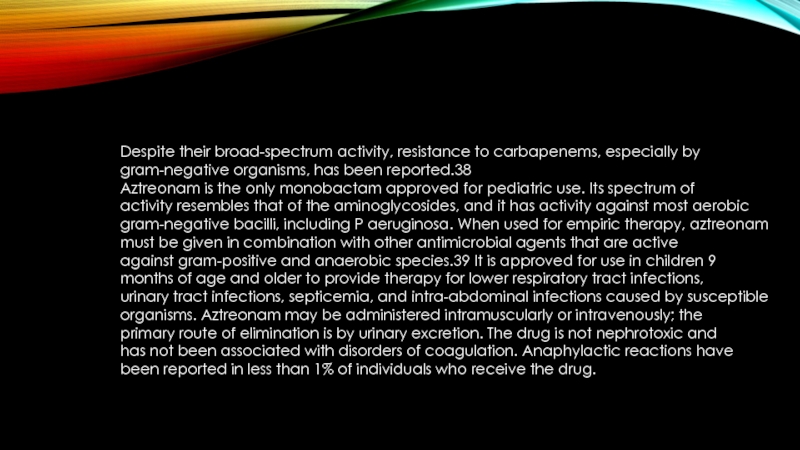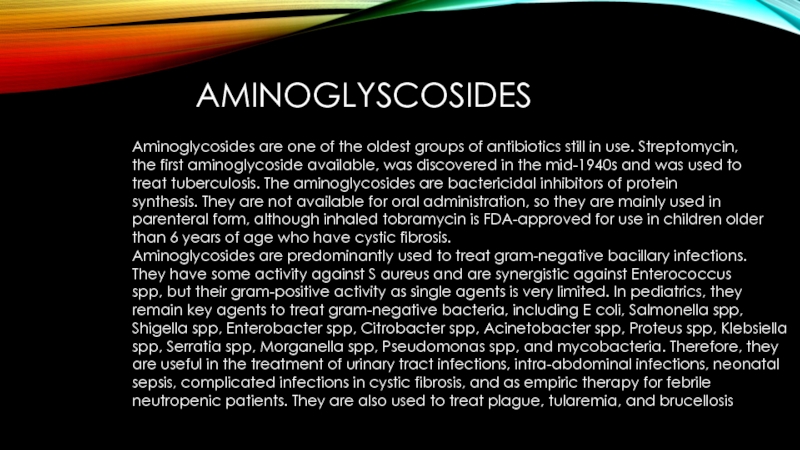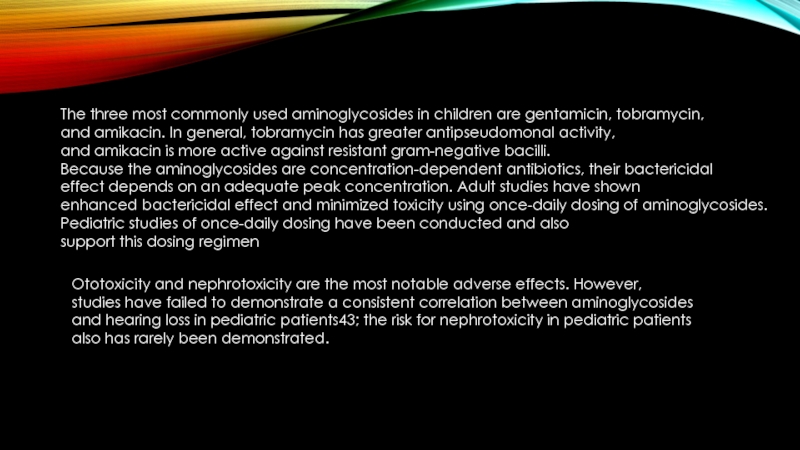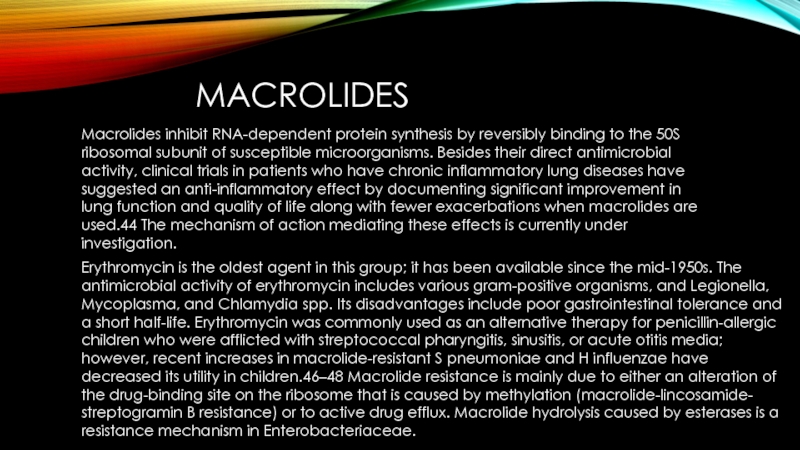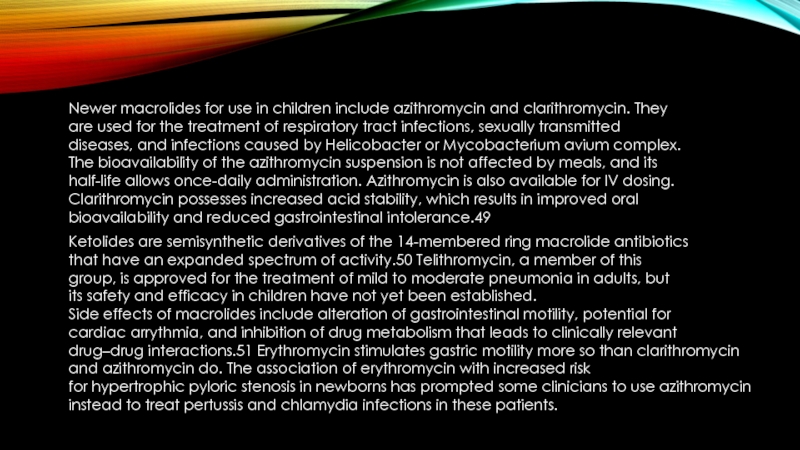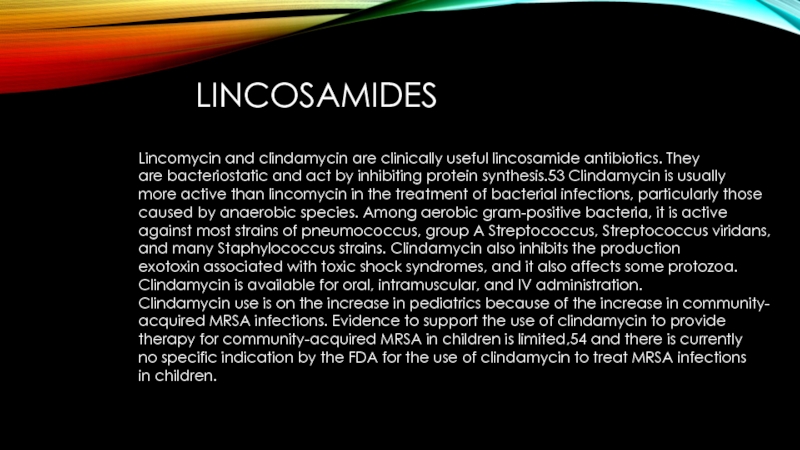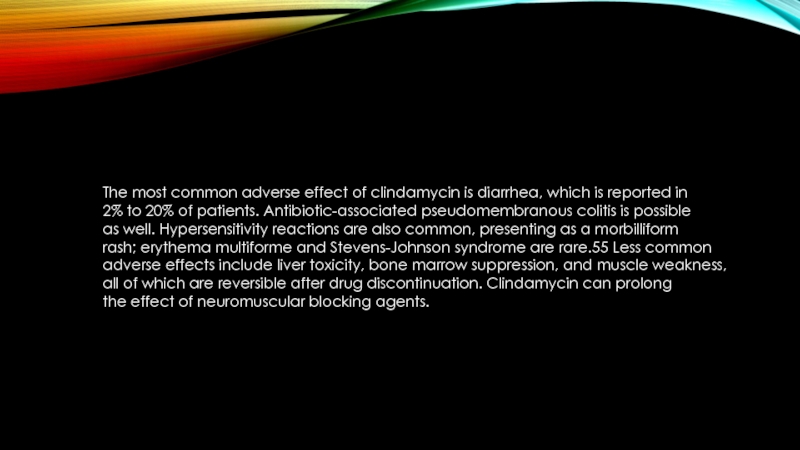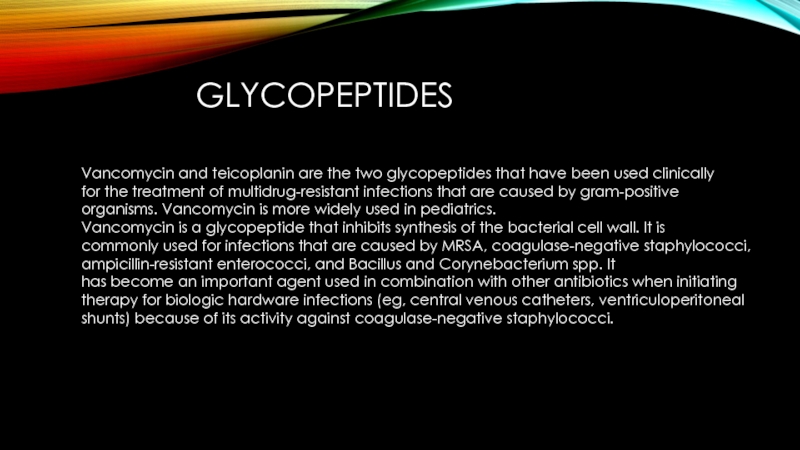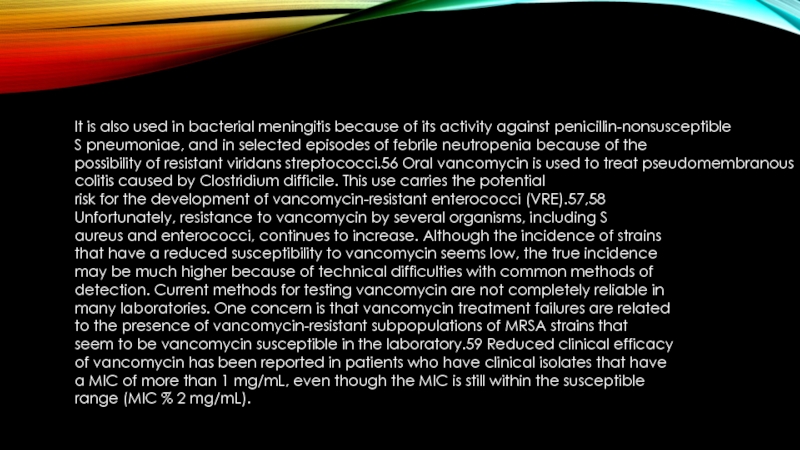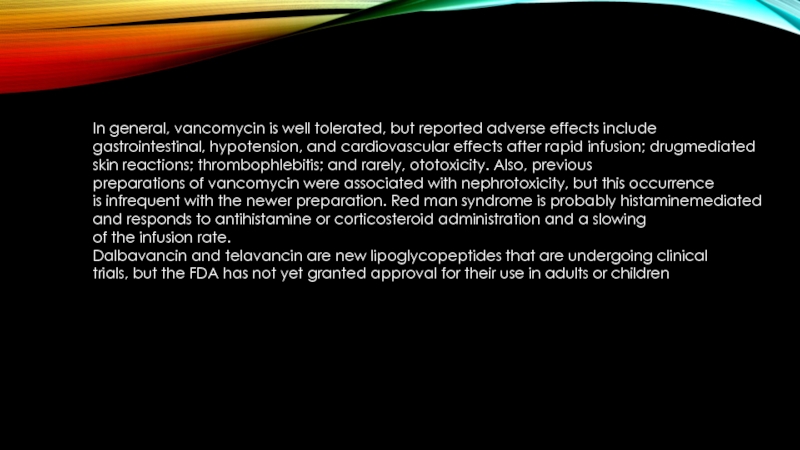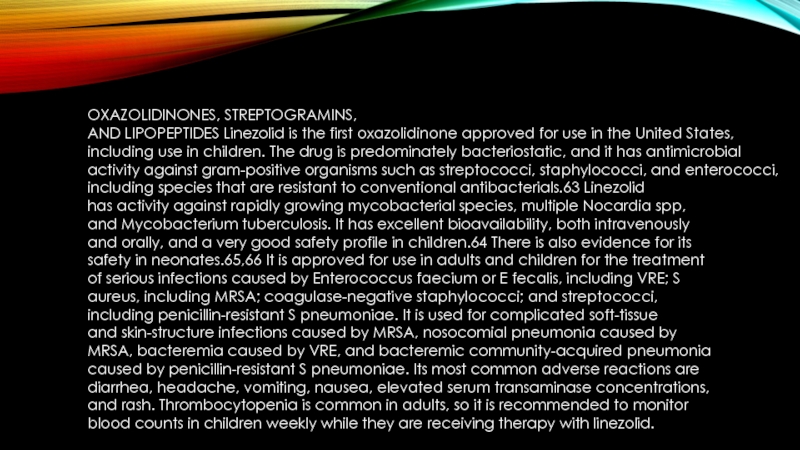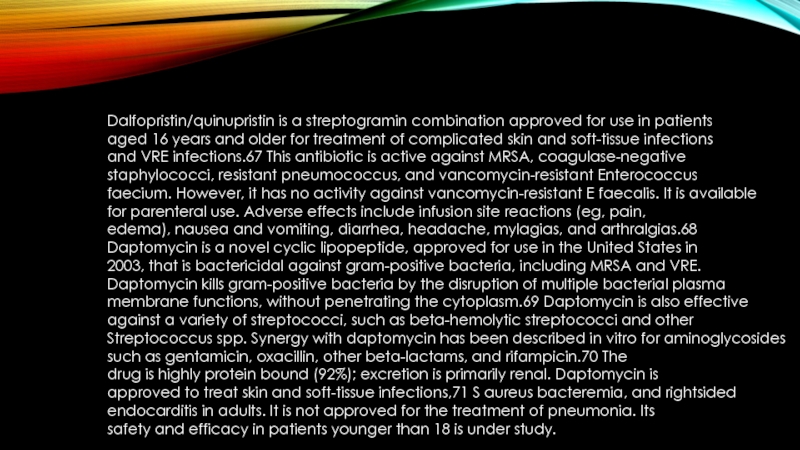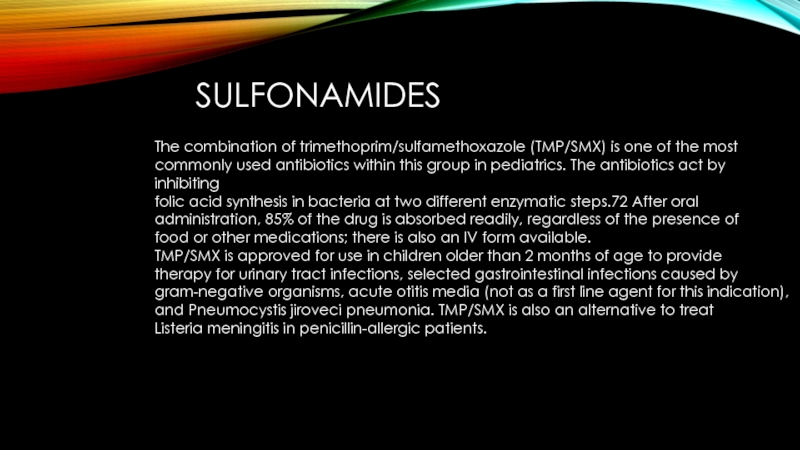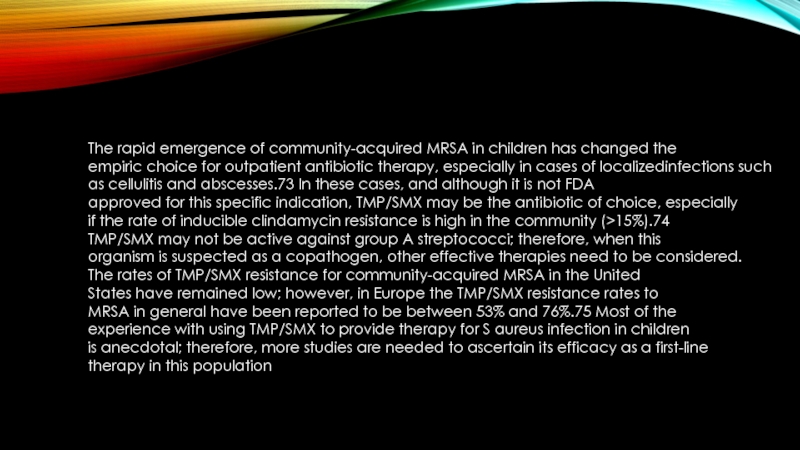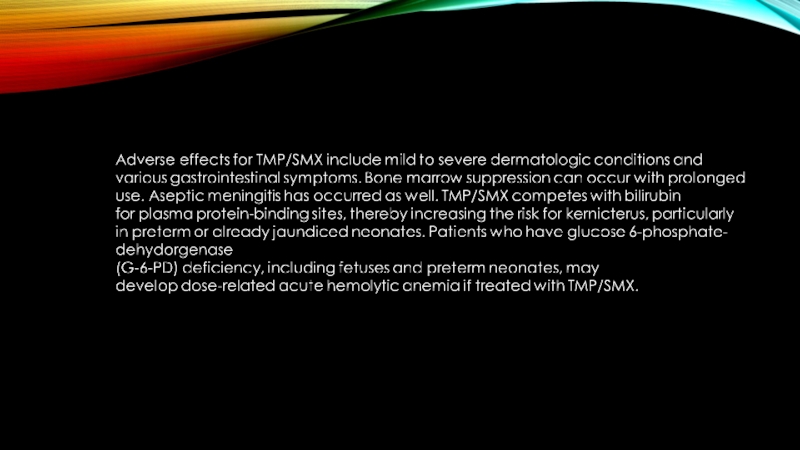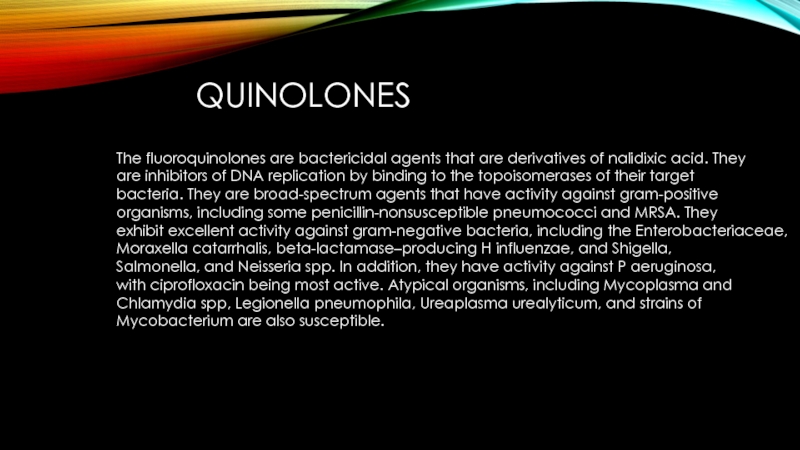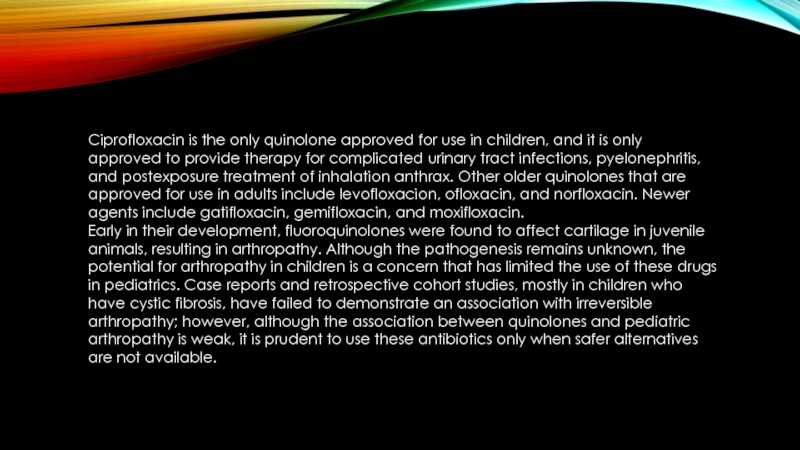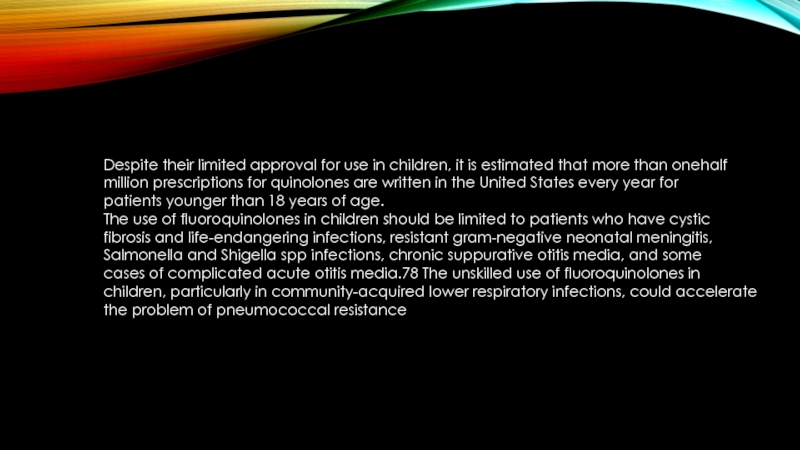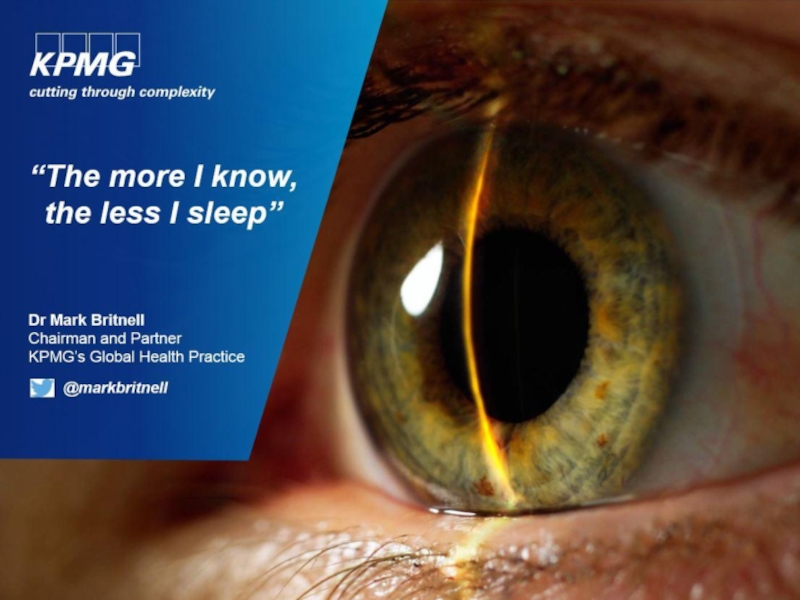- Главная
- Разное
- Дизайн
- Бизнес и предпринимательство
- Аналитика
- Образование
- Развлечения
- Красота и здоровье
- Финансы
- Государство
- Путешествия
- Спорт
- Недвижимость
- Армия
- Графика
- Культурология
- Еда и кулинария
- Лингвистика
- Английский язык
- Астрономия
- Алгебра
- Биология
- География
- Детские презентации
- Информатика
- История
- Литература
- Маркетинг
- Математика
- Медицина
- Менеджмент
- Музыка
- МХК
- Немецкий язык
- ОБЖ
- Обществознание
- Окружающий мир
- Педагогика
- Русский язык
- Технология
- Физика
- Философия
- Химия
- Шаблоны, картинки для презентаций
- Экология
- Экономика
- Юриспруденция
Effect of antibiotics on pediatrics презентация
Содержание
- 1. Effect of antibiotics on pediatrics
- 2. UNDER SUPERVISION OF Prof. Dr : Ramdan El-Domany
- 3. TEAM MEMBERS Abd El-Rahman Mostafa Mohammed Khaled Amr Allam Abdallah Badran
- 4. Antibiotics are the therapeutic agents most frequently
- 5. PHARMACOKINETICS Antibiotic pharmacokinetics describe their absorption, metabolism,
- 6. Certain antibacterial agents (eg, ceftriaxone and the
- 7. Although age correlates with body weight as
- 8. PHARMACODYNAMICS Pharmacodynamics describes the effects, activity, or
- 9. Two main patterns of bactericidal activity exist.
- 10. BETA-LACTAMS Despite the development of resistance by
- 11. these organisms have developed various mechanisms of
- 12. The first semisynthetic penicillin that was stable
- 13. A different approach to counteract beta-lactamase has
- 14. Extended-spectrum penicillins were also developed with the
- 15. CEPHALOSPORINS Cephalosporins are among the most commonly
- 16. Some organisms, including all enterococci, Listeria monocytogenes,
- 17. Newer cephalosporins under investigation and with broader
- 18. Oral third-generation cephalosporins used commonly in pediatrics
- 19. The most widely used parenteral third-generation cephalosporins
- 20. They, like other beta-lactams, can be associated
- 21. CARBAPENEMS AND MONOBACTAMS Carbapenems are a class
- 22. Imipenem is approved for use in pediatrics
- 23. Despite their broad-spectrum activity, resistance to carbapenems,
- 24. AMINOGLYSCOSIDES Aminoglycosides are one of the oldest
- 25. The three most commonly used aminoglycosides in
- 26. MACROLIDES Macrolides inhibit RNA-dependent protein synthesis by
- 27. Newer macrolides for use in children include
- 28. LINCOSAMIDES Lincomycin and clindamycin are clinically useful
- 29. The most common adverse effect of clindamycin
- 30. GLYCOPEPTIDES Vancomycin and teicoplanin are the two
- 31. It is also used in bacterial meningitis
- 32. In general, vancomycin is well tolerated, but
- 33. OXAZOLIDINONES, STREPTOGRAMINS, AND LIPOPEPTIDES Linezolid is
- 34. Dalfopristin/quinupristin is a streptogramin combination approved for
- 35. SULFONAMIDES The combination of trimethoprim/sulfamethoxazole (TMP/SMX) is
- 36. The rapid emergence of community-acquired MRSA in
- 38. QUINOLONES The fluoroquinolones are bactericidal agents that
- 39. Ciprofloxacin is the only quinolone approved for
- 40. Despite their limited approval for use in
- 41. ABDALLAH ADEL 3266 ABDALLAH MAHMOUD SAMY 3268 ABDELRAHMAN MOSTAFA 3264 AMR ALLAM 326
Слайд 4Antibiotics are the therapeutic agents most frequently used in pediatrics. The
problem, especially in outpatient pediatric practices.2 Antibiotics are also widely used to treat infections of the skin and soft tissues, genitourinary tract, bones and joints, central nervous system (CNS), and other sites in patients who require hospitalization.
Despite their widespread use in pediatrics, few antibiotics have been studied adequately to be considered safe and effective for use in children. Unfortunately, data regarding antibiotic pharmacokinetics, efficacy, and side effects are often extrapolated from studies performed in adults or animals when selecting dosing regimens for children. The US Food and Drug Administration (FDA) addressed the issue with the Pediatric Rule
INTRODUCTION
When using antibiotics in children, many factors that are different from those for
adults should be considered
Слайд 5PHARMACOKINETICS
Antibiotic pharmacokinetics describe their absorption, metabolism, elimination, and distribution. Gestational and
Parenteral antibiotic administration often results in higher and more predictable serum concentrations compared with the oral route. Oral bioavailability of most beta-lactam antibiotics, for example, is approximately 5% to 10% compared with the intravenous (IV) route. However, certain antibiotics, including clindamycin, trimethoprim/ sulfamethoxazole, and linezolid, on the other hand, have excellent bioavailability, After administration by the oral route, and the serum concentrations are similar to
those found after an IV dose.
Hepatic function changes over time as the result of variations in blood flow and the maturation of enzyme systems. In neonates, both phase I (primarily oxidation) and phase II enzymes (conjugation) may be reduced, although they are more active by 2 months of age.4 After the first year of life, the levels of most liver enzymes are similar to the levels in adults.5,6 Besides the changes in hepatic metabolism, it is also important to consider the protein binding properties of different antibiotics at different stages of
life. The bilirubin-albumin binding capacity in neonates is very low, and it does not reach adult levels until approximately 5 months of age. Excess unconjugated bilirubin can result in bilirubin encephalopathy (kernicterus)
Слайд 6Certain antibacterial agents (eg, ceftriaxone and the sulfonamides) can increase toxic
Because the risk for kernicterus is directly related to the
serum concentration of unbound, unconjugated bilirubin, these agents should be
avoided in newborns and young infants. Cefotaxime and ceftazidime pose less risk.
Renal function also is determined The glomerular clearance of drugs in neonates is slow compared with that in older children and adults.
Aminoglycosides and glycopeptide antibiotics are almost exclusively eliminated
by the renal route, and adjusted gestational age is the best predictor of their
clearance. The glomerular filtration rate increases during infancy to approach an adult
rate by 6 months of age.8,9 Antibiotic dosing in neonates is further complicated
because neonates have larger total-body-water content and a higher proportion of
extracellular fluid compared with older children, which translates into a larger volume
of distribution.
Слайд 7Although age correlates with body weight as the child grows, pharmacokinetic
parameters
clearance in children exceeds that of adults; therefore, a higher dosage based on
body weight may be necessary. Adjusting dosages based on body surface
area may help to avoid overdosing of certain antibiotics, especially in older children.
Monitoring of antibiotic serum concentrations is sometimes indicated to assess
both efficacy and toxicity.
Слайд 8PHARMACODYNAMICS
Pharmacodynamics describes the effects, activity, or toxicity of a pharmaceutical
agent within
Testing before beginning antibiotic therapy is ideal. The site of infection is another factor to consider
when choosing a particular agent because antibiotic concentrations vary in different compartments.
The MIC is the lowest concentration of the antibiotic that inhibits the growth of the pathogen in vitro. Not all isolates of a pathogen have the same MIC for a given antibiotic.
Two main patterns of bactericidal activity exist. Antibiotics such as penicillins and
cephalosporins demonstrate time-dependent killing, that is, the duration that the
concentration of the drug is greater than the MIC of the target organism is directly
related to bacterial killing.16 Vancomycin, clindamycin, and the macrolides also
show time-dependent antibacterial activity. Bacterial killing by such antibiotics as
the aminoglycosides and fluoroquinolones, on the other hand, is concentration dependent,
that is, a higher drug concentration leads to a greater rate and extent of bacterial
killing.
Слайд 9Two main patterns of bactericidal activity exist. Antibiotics such as penicillins
cephalosporins demonstrate time-dependent killing, that is, the duration that the
concentration of the drug is greater than the MIC of the target organism is directly
related to bacterial killing.16 Vancomycin, clindamycin, and the macrolides also
show time-dependent antibacterial activity. Bacterial killing by such antibiotics as
the aminoglycosides and fluoroquinolones, on the other hand, is concentration dependent, that is, a higher drug concentration leads to a greater rate and extent of bacterial killing.
The duration of therapy is determined in many cases by common practice and
general experience because critical evaluations of therapy duration have been performed
for only a few diseases.
In general, a longer duration of therapy should be
used (1) for tissues in which antibiotic concentrations may not be high (eg, bone),
(2) when the organisms are less susceptible to antibiotic therapy, (3) when a relapse
of infection is unacceptable (eg, CNS infections), or (4) when the host is immunocompromised
in some way
Слайд 10BETA-LACTAMS
Despite the development of resistance by several organisms, this group of
continues to be used against a variety of infections in children. Today, these antibiotics remain the first-line therapy for infection caused by susceptible streptococci, including group A streptococcal pharyngitis.
They are also the drugs of choice in syphilis, meningococcal, Listeria, and neonatal
group B streptococcal infections. Broad-spectrum penicillins, the aminopenicillins, were developed in the 1960s.
Ampicillin, and later amoxicillin, provided activity against gram-negative bacteria
and enterococci.19 Amoxicillin is structurally related to ampicillin and has the same
spectrum of activity and potency. It is much better absorbed when given orally,
achieving blood concentrations approximately twice as high as those obtained with
ampicillin. Initially, aminopenicillins were active against many gram-negative strains
of bacteria, including Escherichia coli, Proteus spp, Salmonella spp, and beta-lactamase–
negative Haemophilus influenzae
Слайд 11these organisms have developed
various mechanisms of resistance, and the aminopenicillins no
the first choice for many of these infections, although they continue to be used against
susceptible isolates. Streptococcus pneumoniae, the most common etiologic agent of
otitis media, is another example of the development of bacterial resistance to penicillins.
Through selection of strains producing penicillin-binding proteins with decreased
affinity for penicillins, the resistance of many strains of S pneumoniae has progressively
increased. However, because the mutations in the penicillin-binding proteins
usually result in only modestly reduced susceptibility, higher doses of aminopenicillins
result in serum concentrations that exceed the MIC for a greater portion of the dosing
interval, thus allowing effective killing
Слайд 12The first semisynthetic penicillin
that was stable to staphylococcal penicillinase was methicillin.
other semisynthetic penicillins that had increased activity and the option of oral administration,
such as cloxacillin, flucloxacillin, and dicloxacillin. Dicloxacillin has excellent
bioavailability as an oral agent, but is poorly palatable, and for treating infections
caused by beta-lactamase–producing organisms in children, it has been replaced
by other antibiotics. Penicillinase-resistant parenteral semisynthetic penicillins that
are more commonly used than methicillin include nafcillin and oxacillin. These antibiotics
are effective for treating methicillin-susceptible Staphylococcus aureus (MSSA)
infections in children. The emergence of methicillin-resistant S aureus (MRSA) in the
pediatric population has caused a decrease in their use in children
Слайд 13A different approach to counteract beta-lactamase has been the development of
beta-lactamase
and clavulanic acid became available in 1980, and it has been widely used in children
to treat otitis media, community-acquired pneumonia, sinusitis, infections of the skin
and subcutaneous tissues, urinary tract infections, and animal and human bites. This
combination has an expanded activity to include MSSA, beta-lactamase–positive H
influenzae, and many anaerobes as well. Sulbactam is another beta-lactamase inhibitor.
In combination with ampicillin for IV administration, it is FDA-approved for use in
children aged 1 year and older for treatment of skin and subcutaneous tissue infections.
Its spectrum of activity is similar to that of amoxicillin/clavulanic acid, and there
is evidence that it is an effective therapy for intra-abdominal infections and meningitis
caused by susceptible organisms
Слайд 14Extended-spectrum penicillins were also developed with the goal of treating infections
caused
hypokalemia and hypernatremia. carboxypenicillins consist of carbenicillin and
ticarcillin. Compared with ampicillin, both have enhanced activity against P aeruginosa
and other gram-negative bacteria. Ticarcillin has greater antipseudomonal activity
compared with carbenicillin in vitro. However, the aminopenicillins continue to have
superior activity against enterococci compared with the carboxypenicillins. Ticarcillin
is approved for use in pediatrics to provide treatment for intra-abdominal infections,
skin and subcutaneous tissue infections, respiratory tract infections, septicemia,
and urinary tract infections caused by susceptible organisms
The combination of
ticarcillin and clavulanic acid is also approved for use in children older than 3 months
of age for similar indications Included in this group are mezlocillin, azlocillin, and piperacillin. Piperacillin is
the ureidopenicillin most commonly used in pediatrics, and its combination with tazobactam,
another penicillinase inhibitor, has been approved to provide therapy for
appendicitis and peritonitis in children aged 2 months and older
Слайд 15CEPHALOSPORINS
Cephalosporins are among the most commonly used beta-lactam antibiotics in children.
Various
molecule, cephalosporin C, which is produced by the fungus Cephalosporium
acremonium. In general, first-generation cephalosporins are
most active against aerobic gram-positive cocci. Second-generation cephalosporins
are more active against selected gram-negative organisms; additionally, cefoxitin and
cefotetan (both cephamycins, the latter not FDA-approved for use in children) are
active against anaerobic bacteria. Third-generation cephalosporins are the most
active against gram-negative organisms, including some with activity against P aeruginosa
(ceftazidime and, to a lesser extent, cefoperazone). Fourth-generation cephalosporins
include cefepime and cefpirome, the latter not FDA-approved for use in
adults or children.
Слайд 16Some organisms, including all enterococci, Listeria monocytogenes, and atypical
pneumonia organisms such
always resistant to all cephalosporins.
Cephalosporins are generally well tolerated. Orally administered cephalosporins
may cause gastrointestinal complaints such as nausea, vomiting, or diarrhea. Thrombophlebitis
occurs in about 1% to 2% of patients who receive cephalosporins intravenously.
Hypersensitivity or allergic reactions occur in 1% to 3% of patients who
receive cephalosporin drugs, and skin testing helps confirm such reactions.28 The
rate of cross-reactive cephalosporin allergy in patients who have known penicillin
allergy is poorly defined, but it appears to be low.29,30 Other side effects include occasional
leukopenia and thrombocytopenia; eosinophilia may occur. Cephalosporins
can also cause hypoprothrombinemia and transient elevation of transaminases;
they are rarely nephrotoxic or neurotoxic.
Слайд 17Newer cephalosporins under investigation and with broader activity, including activity against
Parenteral first-generation cephalosporins are for the most part used to treat bone, urinary tract, respiratory tract, and skin and soft-tissue infections, and for preoperative prophylaxis when indicated.
Cefuroxime is the most commonly used second-generation cephalosporin used in children. It is available for oral and parenteral administration. Cefuroxime is the only cephalosporin of this group that has demonstrable penetration into the CNS.
However, its use for treatment of bacterial meningitis was associated with delayed sterilization and a higher incidence of hearing loss.33 Other indications include pharyngitis, otitis media, lower respiratory tract infections, soft-tissue infections, and urinary tract infections. Other oral second-generation cephalosporins include cefaclor and cefprozil, both with a spectrum of activity similar to cefuroxime axetil. Cefaclor has been associated with serum sickness–like reactions that have limited its use in this patient population. Cefprozil is better tolerated and is more palatable. Loracarbef and cefamandole are second-generation cephalosporins that are no longer available in the United States.
Слайд 18Oral third-generation cephalosporins used commonly in pediatrics include cefixime,
cefpodoxime, ceftibuten, and
older than 6 months of age and is commonly used in urinary tract infections and for
the treatment of Salmonella infections. Cefpodoxime may be dosed once or twice
daily and is approved for use in children older than 2 months of age, but it is poorly
palatable. Ceftibuten has similar coverage to cefpodoxime, and is approved only for
treatment of respiratory tract infections, sinusitis, and otitis media in children aged 6
months and older. Cefdinir has a broader spectrum of activity, with activity against
MSSA and streptococci that is comparable with that of the first-generation agents.
It may be dosed once or twice daily, and it has a favorable taste.
Слайд 19The most widely used parenteral third-generation cephalosporins in children are
ceftriaxone, cefotaxime
compared with second-generation agents against Enterobacteriaceae. In general,
they have activity against penicillin nonsusceptible S pneumoniae and Haemophilus,
Neisseria, and Moraxella spp. Third-generation parenteral cephalosporins are the
drugs of choice for the treatment of many types of bacterial meningitis. Ceftriaxone
has the convenience of dosing once daily for the treatment of most infections. It
can be given either intravenously or intramuscularly. Its affinity to bind albumin can
cause displacement of bilirubin; therefore, it is not recommended for use in neonates,
particularly for those who have hyperbilirubinemia. Ceftriaxone achieves excellent
peak serum concentrations and efficacy against resistant nonmeningeal S pneumoniae
infections.
the use of vancomycin plus a third-generation cephalosporin is recommended when
initiating antibiotic therapy for bacterial meningitis, until culture and susceptibility
results are available. Cefotaxime has equivalent coverage to that of ceftriaxone, and
has no restrictions for use during the newborn period. Ceftazidime is the only thirdgeneration
agent that has activity against susceptible strains of P aeruginosa
Слайд 20They, like other beta-lactams, can be associated with
agranulocytosis, thrombocytopenia, pseudomembranous colitis,
reactions. Ceftriaxone has been associated with reversible pseudocholelithiasis. Its
administration with any calcium-containing IV solutions should be avoided
Cefepime is a parenterally administered fourth-generation cephalosporin that was
first approved by the FDA in 1997. It has good activity against gram-positive bacteria,
including MSSA and a-hemolytic streptococci. Also, it has the best activity against
penicillin-resistant pneumococcus among the cephalosporins. In addition, its gramnegative
activity against H influenzae, Neisseria spp, and Pseudomonas spp is excellent.
It is also more active against Enterobacteriaceae, including strains that produce
extended-spectrum beta-lactamases, than third-generation cephalosporins are.35
Cefepime is FDA-approved for use in children older than 2 months of age for empiric
therapy of febrile neutropenia, and to treat skin and soft-tissue infections, moderate to
severe pneumonia, and urinary tract infections. Adverse effects associated with cefepime
use include headache, gastrointestinal upset, local reactions, and rash that
occur in less than 2% of individuals. More serious adverse effects include encephalopathy
and seizures.
Слайд 21CARBAPENEMS AND MONOBACTAMS
Carbapenems are a class of antibiotics that have one
very similar to that of the penicillin ring, with the side chain providing resistance to
most beta-lactamase enzymes. Imipenem, meropenem and ertapenem have activity
against most gram-negative and gram-positive organisms, with differences in activity
that depend on the particular beta-lactamase produced by the pathogen. Meropenem
is less active against gram-positive organisms and more active against gram-negative
organisms than imipenem. Ertapenem has decreased activity against Pseudomonas
isolates compared with imipenem and meropenem. Carbapenems are not active
against MRSA, Enterococcus faecium, Burkholderia cepacia, Stenotrophomonas maltophilia, Chlamydia spp, and Mycoplasma spp
Слайд 22Imipenem is approved for use in pediatrics to treat endocarditis, septicemia,
intra-abdominal, bone, and urinary tract infections. Meropenem is approved for use
in children older than 3 months of age to provide therapy for meningitis (recommended
dose for this indication of 120 mg/kg/day, maximum dose of 6 g/day), skin and soft-tissue infections, and intra-abdominal infections. Ertapenem is approved
for use in children older than 3 months of age to provide therapy for severe pneumonia,
complicated skin and soft-tissue infections, and intra-abdominal and pelvic infections.
Carbapenems are administered parenterally, and their excretion is predominantly
by glomerular filtration. Imipenem must be administered with cilastatin to avoid
hydrolysis and to reduce nephrotoxicity. In general, tolerability to carbapenems
is good.36 Seizures are a well-known side effect of imipenem/cilastatin, especially
in patients who have meningitis. Seizures occur in approximately 3% of patients
who are treated with imipenem and who do not have CNS infections, but the incidence
of seizures can be as high as 33% in patients who have bacterial
meningitis
Слайд 23Despite their broad-spectrum activity, resistance to carbapenems, especially by
gram-negative organisms, has
Aztreonam is the only monobactam approved for pediatric use. Its spectrum of
activity resembles that of the aminoglycosides, and it has activity against most aerobic
gram-negative bacilli, including P aeruginosa. When used for empiric therapy, aztreonam
must be given in combination with other antimicrobial agents that are active
against gram-positive and anaerobic species.39 It is approved for use in children 9
months of age and older to provide therapy for lower respiratory tract infections,
urinary tract infections, septicemia, and intra-abdominal infections caused by susceptible
organisms. Aztreonam may be administered intramuscularly or intravenously; the
primary route of elimination is by urinary excretion. The drug is not nephrotoxic and
has not been associated with disorders of coagulation. Anaphylactic reactions have
been reported in less than 1% of individuals who receive the drug.
Слайд 24AMINOGLYSCOSIDES
Aminoglycosides are one of the oldest groups of antibiotics still in
the first aminoglycoside available, was discovered in the mid-1940s and was used to
treat tuberculosis. The aminoglycosides are bactericidal inhibitors of protein
synthesis. They are not available for oral administration, so they are mainly used in
parenteral form, although inhaled tobramycin is FDA-approved for use in children older
than 6 years of age who have cystic fibrosis.
Aminoglycosides are predominantly used to treat gram-negative bacillary infections.
They have some activity against S aureus and are synergistic against Enterococcus
spp, but their gram-positive activity as single agents is very limited. In pediatrics, they remain key agents to treat gram-negative bacteria, including E coli, Salmonella spp, Shigella spp, Enterobacter spp, Citrobacter spp, Acinetobacter spp, Proteus spp, Klebsiella spp, Serratia spp, Morganella spp, Pseudomonas spp, and mycobacteria. Therefore, they are useful in the treatment of urinary tract infections, intra-abdominal infections, neonatal sepsis, complicated infections in cystic fibrosis, and as empiric therapy for febrile neutropenic patients. They are also used to treat plague, tularemia, and brucellosis
Слайд 25The three most commonly used aminoglycosides in children are gentamicin, tobramycin,
and
and amikacin is more active against resistant gram-negative bacilli.
Because the aminoglycosides are concentration-dependent antibiotics, their bactericidal
effect depends on an adequate peak concentration. Adult studies have shown
enhanced bactericidal effect and minimized toxicity using once-daily dosing of aminoglycosides.
Pediatric studies of once-daily dosing have been conducted and also
support this dosing regimen
Ototoxicity and nephrotoxicity are the most notable adverse effects. However,
studies have failed to demonstrate a consistent correlation between aminoglycosides
and hearing loss in pediatric patients43; the risk for nephrotoxicity in pediatric patients
also has rarely been demonstrated.
Слайд 26MACROLIDES
Macrolides inhibit RNA-dependent protein synthesis by reversibly binding to the 50S
ribosomal
activity, clinical trials in patients who have chronic inflammatory lung diseases have
suggested an anti-inflammatory effect by documenting significant improvement in
lung function and quality of life along with fewer exacerbations when macrolides are
used.44 The mechanism of action mediating these effects is currently under
investigation.
Erythromycin is the oldest agent in this group; it has been available since the mid-1950s. The antimicrobial activity of erythromycin includes various gram-positive organisms, and Legionella, Mycoplasma, and Chlamydia spp. Its disadvantages include poor gastrointestinal tolerance and a short half-life. Erythromycin was commonly used as an alternative therapy for penicillin-allergic children who were afflicted with streptococcal pharyngitis, sinusitis, or acute otitis media; however, recent increases in macrolide-resistant S pneumoniae and H influenzae have decreased its utility in children.46–48 Macrolide resistance is mainly due to either an alteration of
the drug-binding site on the ribosome that is caused by methylation (macrolide-lincosamide- streptogramin B resistance) or to active drug efflux. Macrolide hydrolysis caused by esterases is a resistance mechanism in Enterobacteriaceae.
Слайд 27Newer macrolides for use in children include azithromycin and clarithromycin. They
are
diseases, and infections caused by Helicobacter or Mycobacterium avium complex.
The bioavailability of the azithromycin suspension is not affected by meals, and its
half-life allows once-daily administration. Azithromycin is also available for IV dosing.
Clarithromycin possesses increased acid stability, which results in improved oral
bioavailability and reduced gastrointestinal intolerance.49
Ketolides are semisynthetic derivatives of the 14-membered ring macrolide antibiotics
that have an expanded spectrum of activity.50 Telithromycin, a member of this
group, is approved for the treatment of mild to moderate pneumonia in adults, but
its safety and efficacy in children have not yet been established.
Side effects of macrolides include alteration of gastrointestinal motility, potential for
cardiac arrythmia, and inhibition of drug metabolism that leads to clinically relevant
drug–drug interactions.51 Erythromycin stimulates gastric motility more so than clarithromycin
and azithromycin do. The association of erythromycin with increased risk
for hypertrophic pyloric stenosis in newborns has prompted some clinicians to use azithromycin
instead to treat pertussis and chlamydia infections in these patients.
Слайд 28LINCOSAMIDES
Lincomycin and clindamycin are clinically useful lincosamide antibiotics. They
are bacteriostatic and
more active than lincomycin in the treatment of bacterial infections, particularly those
caused by anaerobic species. Among aerobic gram-positive bacteria, it is active
against most strains of pneumococcus, group A Streptococcus, Streptococcus viridans,
and many Staphylococcus strains. Clindamycin also inhibits the production
exotoxin associated with toxic shock syndromes, and it also affects some protozoa.
Clindamycin is available for oral, intramuscular, and IV administration.
Clindamycin use is on the increase in pediatrics because of the increase in community-
acquired MRSA infections. Evidence to support the use of clindamycin to provide
therapy for community-acquired MRSA in children is limited,54 and there is currently
no specific indication by the FDA for the use of clindamycin to treat MRSA infections
in children.
Слайд 29The most common adverse effect of clindamycin is diarrhea, which is
2% to 20% of patients. Antibiotic-associated pseudomembranous colitis is possible
as well. Hypersensitivity reactions are also common, presenting as a morbilliform
rash; erythema multiforme and Stevens-Johnson syndrome are rare.55 Less common
adverse effects include liver toxicity, bone marrow suppression, and muscle weakness,
all of which are reversible after drug discontinuation. Clindamycin can prolong
the effect of neuromuscular blocking agents.
Слайд 30GLYCOPEPTIDES
Vancomycin and teicoplanin are the two glycopeptides that have been used
for the treatment of multidrug-resistant infections that are caused by gram-positive
organisms. Vancomycin is more widely used in pediatrics.
Vancomycin is a glycopeptide that inhibits synthesis of the bacterial cell wall. It is
commonly used for infections that are caused by MRSA, coagulase-negative staphylococci,
ampicillin-resistant enterococci, and Bacillus and Corynebacterium spp. It
has become an important agent used in combination with other antibiotics when initiating
therapy for biologic hardware infections (eg, central venous catheters, ventriculoperitoneal
shunts) because of its activity against coagulase-negative staphylococci.
Слайд 31It is also used in bacterial meningitis because of its activity
S pneumoniae, and in selected episodes of febrile neutropenia because of the
possibility of resistant viridans streptococci.56 Oral vancomycin is used to treat pseudomembranous
colitis caused by Clostridium difficile. This use carries the potential
risk for the development of vancomycin-resistant enterococci (VRE).57,58
Unfortunately, resistance to vancomycin by several organisms, including S
aureus and enterococci, continues to increase. Although the incidence of strains
that have a reduced susceptibility to vancomycin seems low, the true incidence
may be much higher because of technical difficulties with common methods of
detection. Current methods for testing vancomycin are not completely reliable in
many laboratories. One concern is that vancomycin treatment failures are related
to the presence of vancomycin-resistant subpopulations of MRSA strains that
seem to be vancomycin susceptible in the laboratory.59 Reduced clinical efficacy
of vancomycin has been reported in patients who have clinical isolates that have
a MIC of more than 1 mg/mL, even though the MIC is still within the susceptible
range (MIC % 2 mg/mL).
Слайд 32In general, vancomycin is well tolerated, but reported adverse effects include
gastrointestinal,
skin reactions; thrombophlebitis; and rarely, ototoxicity. Also, previous
preparations of vancomycin were associated with nephrotoxicity, but this occurrence
is infrequent with the newer preparation. Red man syndrome is probably histaminemediated
and responds to antihistamine or corticosteroid administration and a slowing
of the infusion rate.
Dalbavancin and telavancin are new lipoglycopeptides that are undergoing clinical
trials, but the FDA has not yet granted approval for their use in adults or children
Слайд 33OXAZOLIDINONES, STREPTOGRAMINS,
AND LIPOPEPTIDES Linezolid is the first oxazolidinone approved for
including species that are resistant to conventional antibacterials.63 Linezolid
has activity against rapidly growing mycobacterial species, multiple Nocardia spp,
and Mycobacterium tuberculosis. It has excellent bioavailability, both intravenously
and orally, and a very good safety profile in children.64 There is also evidence for its
safety in neonates.65,66 It is approved for use in adults and children for the treatment
of serious infections caused by Enterococcus faecium or E fecalis, including VRE; S
aureus, including MRSA; coagulase-negative staphylococci; and streptococci,
including penicillin-resistant S pneumoniae. It is used for complicated soft-tissue
and skin-structure infections caused by MRSA, nosocomial pneumonia caused by
MRSA, bacteremia caused by VRE, and bacteremic community-acquired pneumonia
caused by penicillin-resistant S pneumoniae. Its most common adverse reactions are
diarrhea, headache, vomiting, nausea, elevated serum transaminase concentrations,
and rash. Thrombocytopenia is common in adults, so it is recommended to monitor
blood counts in children weekly while they are receiving therapy with linezolid.
Слайд 34Dalfopristin/quinupristin is a streptogramin combination approved for use in patients
aged 16
and VRE infections.67 This antibiotic is active against MRSA, coagulase-negative
staphylococci, resistant pneumococcus, and vancomycin-resistant Enterococcus
faecium. However, it has no activity against vancomycin-resistant E faecalis. It is available
for parenteral use. Adverse effects include infusion site reactions (eg, pain,
edema), nausea and vomiting, diarrhea, headache, mylagias, and arthralgias.68
Daptomycin is a novel cyclic lipopeptide, approved for use in the United States in
2003, that is bactericidal against gram-positive bacteria, including MRSA and VRE.
Daptomycin kills gram-positive bacteria by the disruption of multiple bacterial plasma
membrane functions, without penetrating the cytoplasm.69 Daptomycin is also effective
against a variety of streptococci, such as beta-hemolytic streptococci and other
Streptococcus spp. Synergy with daptomycin has been described in vitro for aminoglycosides
such as gentamicin, oxacillin, other beta-lactams, and rifampicin.70 The
drug is highly protein bound (92%); excretion is primarily renal. Daptomycin is
approved to treat skin and soft-tissue infections,71 S aureus bacteremia, and rightsided
endocarditis in adults. It is not approved for the treatment of pneumonia. Its
safety and efficacy in patients younger than 18 is under study.
Слайд 35SULFONAMIDES
The combination of trimethoprim/sulfamethoxazole (TMP/SMX) is one of the most
commonly used
folic acid synthesis in bacteria at two different enzymatic steps.72 After oral
administration, 85% of the drug is absorbed readily, regardless of the presence of
food or other medications; there is also an IV form available.
TMP/SMX is approved for use in children older than 2 months of age to provide
therapy for urinary tract infections, selected gastrointestinal infections caused by
gram-negative organisms, acute otitis media (not as a first line agent for this indication),
and Pneumocystis jiroveci pneumonia. TMP/SMX is also an alternative to treat
Listeria meningitis in penicillin-allergic patients.
Слайд 36The rapid emergence of community-acquired MRSA in children has changed the
empiric
approved for this specific indication, TMP/SMX may be the antibiotic of choice, especially
if the rate of inducible clindamycin resistance is high in the community (>15%).74
TMP/SMX may not be active against group A streptococci; therefore, when this
organism is suspected as a copathogen, other effective therapies need to be considered.
The rates of TMP/SMX resistance for community-acquired MRSA in the United
States have remained low; however, in Europe the TMP/SMX resistance rates to
MRSA in general have been reported to be between 53% and 76%.75 Most of the
experience with using TMP/SMX to provide therapy for S aureus infection in children
is anecdotal; therefore, more studies are needed to ascertain its efficacy as a first-line
therapy in this population
Слайд 38QUINOLONES
The fluoroquinolones are bactericidal agents that are derivatives of nalidixic acid.
are inhibitors of DNA replication by binding to the topoisomerases of their target
bacteria. They are broad-spectrum agents that have activity against gram-positive
organisms, including some penicillin-nonsusceptible pneumococci and MRSA. They
exhibit excellent activity against gram-negative bacteria, including the Enterobacteriaceae,
Moraxella catarrhalis, beta-lactamase–producing H influenzae, and Shigella,
Salmonella, and Neisseria spp. In addition, they have activity against P aeruginosa,
with ciprofloxacin being most active. Atypical organisms, including Mycoplasma and
Chlamydia spp, Legionella pneumophila, Ureaplasma urealyticum, and strains of
Mycobacterium are also susceptible.
Слайд 39Ciprofloxacin is the only quinolone approved for use in children, and
approved to provide therapy for complicated urinary tract infections, pyelonephritis,
and postexposure treatment of inhalation anthrax. Other older quinolones that are
approved for use in adults include levofloxacion, ofloxacin, and norfloxacin. Newer
agents include gatifloxacin, gemifloxacin, and moxifloxacin.
Early in their development, fluoroquinolones were found to affect cartilage in juvenile
animals, resulting in arthropathy. Although the pathogenesis remains unknown, the
potential for arthropathy in children is a concern that has limited the use of these drugs
in pediatrics. Case reports and retrospective cohort studies, mostly in children who
have cystic fibrosis, have failed to demonstrate an association with irreversible
arthropathy; however, although the association between quinolones and pediatric
arthropathy is weak, it is prudent to use these antibiotics only when safer alternatives
are not available.
Слайд 40Despite their limited approval for use in children, it is estimated
million prescriptions for quinolones are written in the United States every year for
patients younger than 18 years of age.
The use of fluoroquinolones in children should be limited to patients who have cystic
fibrosis and life-endangering infections, resistant gram-negative neonatal meningitis,
Salmonella and Shigella spp infections, chronic suppurative otitis media, and some
cases of complicated acute otitis media.78 The unskilled use of fluoroquinolones in
children, particularly in community-acquired lower respiratory infections, could accelerate
the problem of pneumococcal resistance
